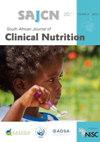The predictors of different measures of dietary diversity among one-year-olds in South Africa
IF 0.6
Q4 NUTRITION & DIETETICS
引用次数: 0
Abstract
Objectives: A study was undertaken to compare a range of dietary diversity indicators and their predictors among one-year-olds. Design: Multivariate regression analysis was employed, where dietary diversity indicators are the outcome variables and the main predictor variables are access to resources and maternal education. Three different dietary diversity indicators are analysed: a count of food items, a count of food groups and a Healthy Food Diversity Index. Subjects and setting: The study included participants of Birth to Twenty Plus, a longitudinal cohort study of children born in 1990 in Johannesburg, South Africa (n = 1 030). Results: There is a low correlation between measures of dietary diversity based on simple counts of food items/groups and the Healthy Food Diversity Index. Further, the predictors differ depending on which type of indicator is used. Access to resources (measured by an asset index) was found to be associated with an increase in counts of food items/groups but at a decreasing rate, while the opposite was found for the Healthy Food Diversity Index. There was no significant association between maternal education and the counts of food items/groups, while maternal education was positively associated with the Healthy Food Diversity Index. Conclusions: More sophisticated measures of dietary diversity that also capture the healthiness of foods and their distribution in the diet, rather than just the number or variety, may be useful in understanding dietary patterns among children and what influences them. Maternal education appears to be particularly important for healthy food consumption among young children, while access to resources has a more complex association, with differential results at low and high levels.南非一岁儿童饮食多样性的不同衡量指标的预测因素
目的:进行一项研究,比较1岁儿童饮食多样性指标及其预测因素。设计:采用多元回归分析,以饮食多样性指标为结局变量,资源获取和母亲教育为主要预测变量。本文分析了三种不同的饮食多样性指标:食物种类数、食物组数和健康食物多样性指数。研究对象和环境:本研究纳入了《从出生到20多岁》的参与者,这是一项对1990年在南非约翰内斯堡出生的儿童进行的纵向队列研究(n = 1030)。结果:基于食物种类/组的简单计数的饮食多样性测量与健康食品多样性指数之间的相关性较低。此外,根据所使用的指标类型不同,预测结果也不同。研究发现,获取资源(以资产指数衡量)与食品种类/类别数量的增加有关,但其增加速度呈下降趋势,而健康食品多样性指数则相反。母亲受教育程度与食物种类/类别数量之间无显著相关,而母亲受教育程度与健康食物多样性指数呈正相关。结论:更复杂的饮食多样性测量方法也能捕捉食物的健康状况及其在饮食中的分布,而不仅仅是数量或种类,这可能有助于了解儿童的饮食模式及其影响因素。产妇教育似乎对幼儿的健康食品消费特别重要,而获取资源则具有更复杂的关联,在低水平和高水平的结果有所不同。
本文章由计算机程序翻译,如有差异,请以英文原文为准。
求助全文
约1分钟内获得全文
求助全文
来源期刊

South African Journal of Clinical Nutrition
NUTRITION & DIETETICS-
CiteScore
2.50
自引率
9.10%
发文量
21
期刊介绍:
1.The Journal accepts articles from all basic and applied areas of dietetics and human nutrition, including clinical nutrition, community nutrition, food science, food policy, food service management, nutrition policy and public health nutrition. 2.The Journal has a broad interpretation of the field of nutrition and recognizes that there are many factors that determine nutritional status and that need to be the subject of scientific investigation and reported in the Journal. 3.The Journal seeks to serve a broad readership and to provide information that will be useful to the scientific community, the academic community, government and non-government stakeholders in the nutrition field, policy makers and industry.
 求助内容:
求助内容: 应助结果提醒方式:
应助结果提醒方式:


